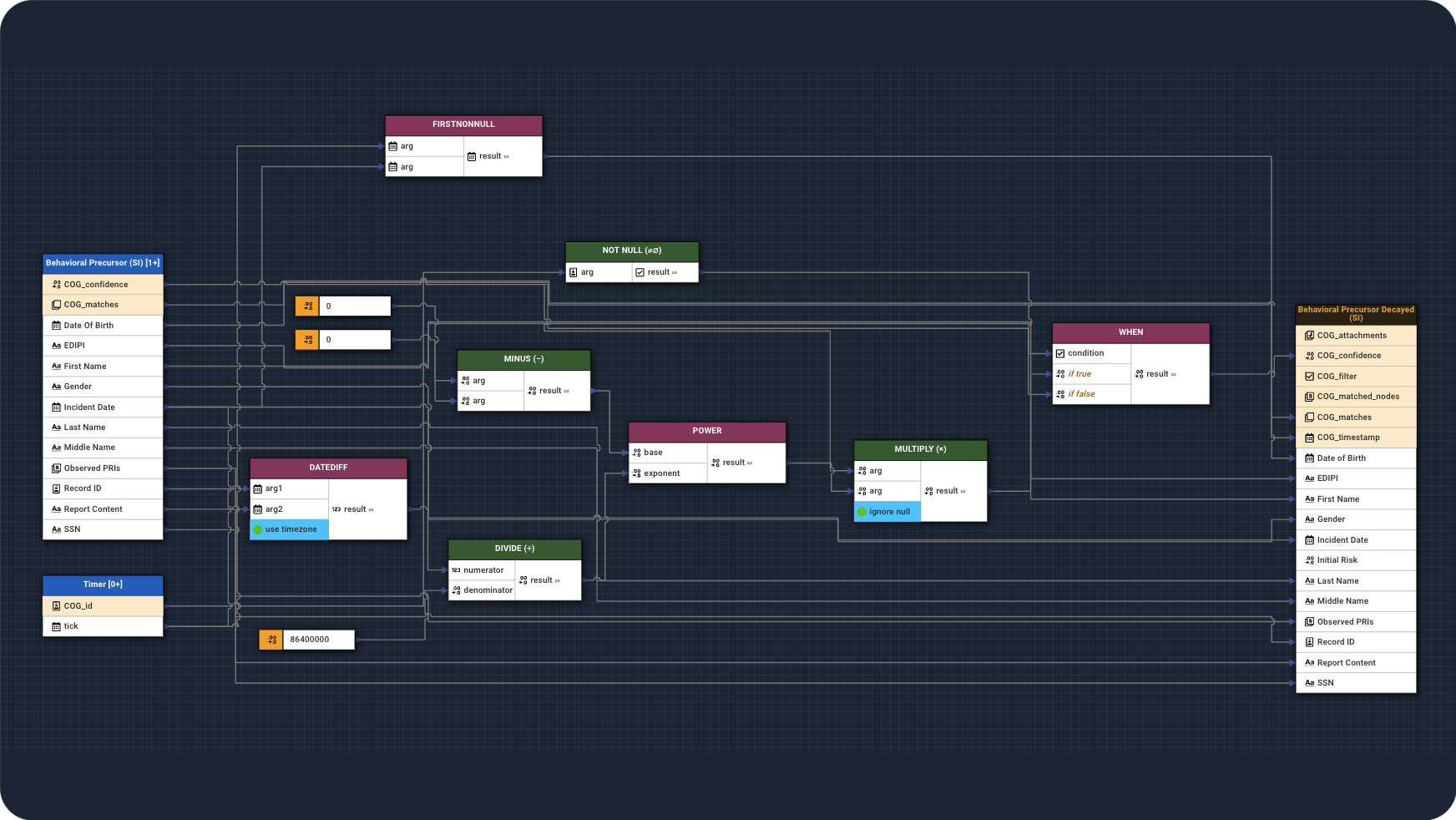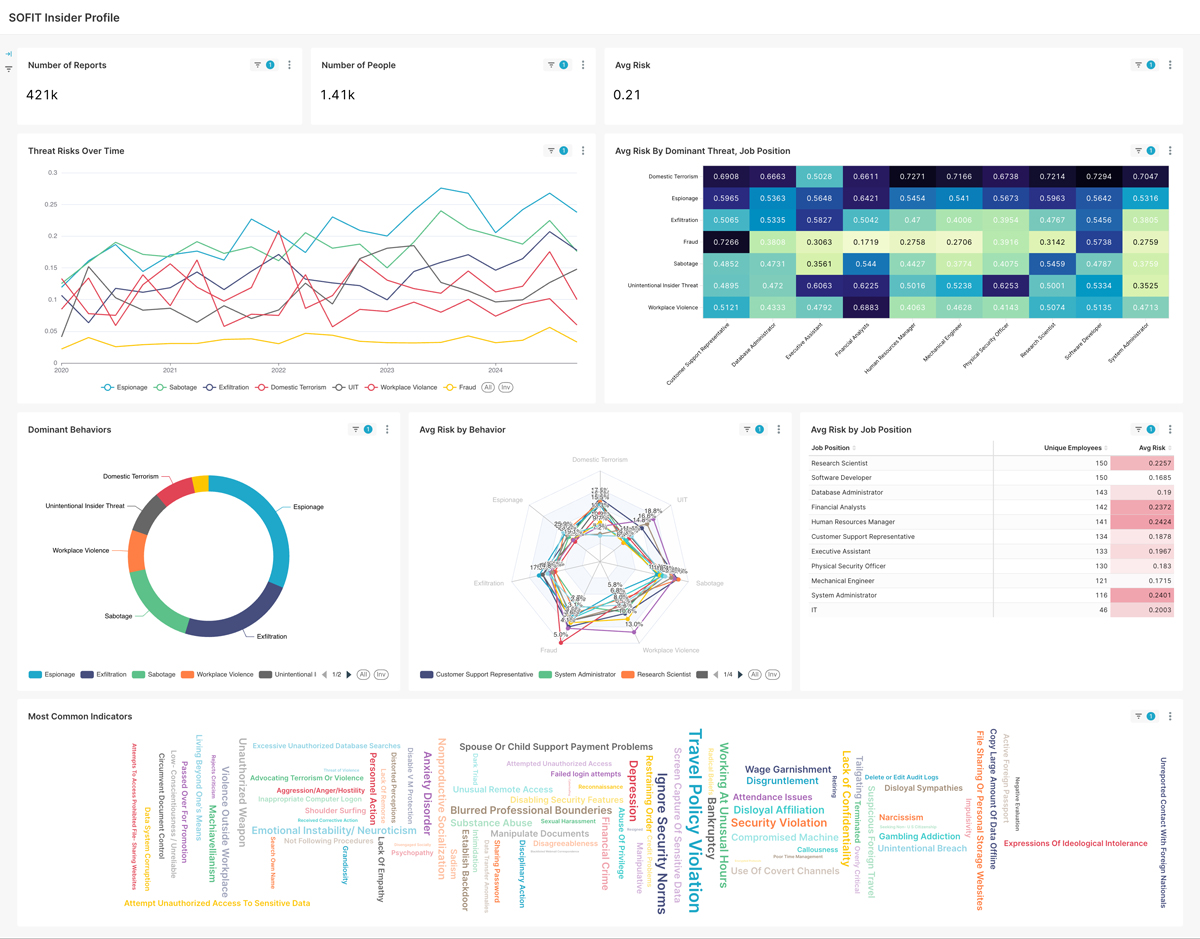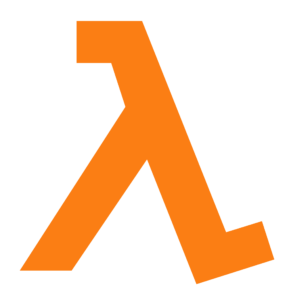
Cogynt™ Decision Intelligence Platform
Accelerate Decision Intelligence Application Delivery to Modernize Decision Support
Cogynt™ provides the most comprehensive, versatile, and simplified means to deliver continuous decision intelligence applications that automate decision support. Cogynt integrates event stream processing, advanced behavioral analytics, no-code modeling, and investigative analysis tools and visualizations — enabling organizations to transform massive, diverse data into predictive and actionable intelligence.
- Make faster, informed, and auditable decisions with greater effectiveness, precision, consistency, and collaboration
- Enable analysts and data scientists to directly design models and efficiently optimize outcomes
- Streamline decision intelligence (DI) application delivery and enhancement while mitigating technical, operational, schedule and cost risks
Intuitive Cohesive Capabilities
Whether you’re developing models, examining findings, sharing insights, or enabling workflow, Cogynt's integrated capabilities and intuitive interface are optimized for the task at hand.

Cogynt’s Authoring Tool is no-code design environment to create, deploy, and update models and data sources.
- Reduces modeling effort to define and map source data (Kafka): streaming or batch ingestion of structured, unstructured, database, and AI data
- Models support logic repurposing, data and are self-documenting to support efficient on-going development
- A rich library of computations and calculation functions offers virtually unlimited options for real-time data analysis
- Built-in safeguards, including automatic consistency checks help reduce processing errors

Cogynt’s Hierarchical Complex Event Processing (HCEP) provides a simple, yet sophisticated method to analyze multifaceted patterns within diverse, high-volume event streams in real time to determine insights.
- Computational hierarchy allows smaller behavior indication patterns to feed larger ones to determine target insights
- Maintains stateful analysis of current and pending patterns to enable incremental evaluation of indicators immediately and over time
- Applies advanced computational and probabilistic analysis at every level of hierarchy to ensure accurate predictions

Analyst Workstation facilitates reviewing model results, sharing intelligence findings, facilitating action, and gaining operational oversight.
- Robust visualization and widget-based tools let analysts see the entire picture from any angle
- Analysts can examine, assess, annotate and enrich insight findings, and request contributors
- Integrated case management improves productivity, oversight, and collaboration workflow
- Built-in dashboards and report writing capabilities make it easy to convey intelligence insights

The Superset Tool provides an up-to-date, bird’s-eye view of the organization’s key performance indicators (KPIs).
- Business Intelligence features to support program operational oversight
- Dynamically updated KPI status and tracking
- Allows program managers, directors, and stakeholders to create customized charts and interactive dashboards
- Facilitates access to other preferred dashboards through Cogynt’s open system architecture
Platform Integration and Scale
Cogynt is a cohesive DIP platform that incorporates and augments proven Apache Software Foundation technology and operates at cloud-scale to meet high-volume data ingestion and complex analytic processing demands.
Cogynt’s integrated packaging, non-disruptive implementation, and advanced management features expedite deployment in an organization’s virtual private cloud (VPC) within leading cloud service providers.
Platform Advantages
Cogynt streamlines deployment, creating and refining models, ingesting data sources, and processing event streams while automating visualization, investigation, workflow, and integration processes.
Reduced DIP Overhead
Automated packaging, deployment, and model production expedites DI application delivery, reduces engineering overhead, and negates requiring Flink, Kafka, and Pinot expertise.
No-Code Model Authoring
Intuitive model authoring enables analysts and data scientists to define lexicon, event patterns, and computation logic using a declarative system that removes the need for coding or SQL expertise.
Advanced Behavioral Analytic
Patented Hierarchical Complex Event Processing (HCEP) detects, tracks, and scores complicated patterns of behavior with full contextualization whether occurring infrequently or evolving over time.
Leverages Expert AI & Gen AI
Expert AI enables SME expertise to become machine-speed analytics, yielding insights with full data lineage. Forthcoming LLM-powered AI, will enhance source data assessment, authoring, and workflow experiences.
Flexible Data Ingestion
Guided logic easily defines streamed or batch ingestion of structured, unstructured, database, and AI data sources leveraging automated topic schema mapping.
Workflow Automation
Complete case management enables DI dissemination to analysts and stakeholders, as well as integration with other applications and AI systems.
DIP Architecture Considerations: Build vs Buy
Beyond requiring technical expertise and staffing, attempting to build DI applications with piecemeal toolsets to support DIP creates ongoing complexity, efficiency, and operational challenges. As engineers and data scientists develop and extend DI applications, expanding data sources, creating and improving analytic models, and integrating findings into existing workflows becomes burdensome to enhance and maintain.
Cogynt delivers an end-to-end, modern DIP designed to increase DI application delivery efficiency with accelerated time-to-value at the lowest total-cost-of-ownership. A cohesive, proven, well-supported commercial off-the-shelf (COTS) solution, Cogynt can be rapidly deployed and easily scaled. With its Expert AI approach to DI development, Cogynt enables analysts and data scientists to directly design models and optimize results without coding — reducing release cycles, engineering overhead, and expenditure.

Real-Time Behavioral Analysis
Hierarchical Complex Event Processing (HCEP) defines event patterns from the top down, starting with a hypothesis as expressed in a Cogynt model. The top-level event pattern is then decomposed into lower-level patterns until the analysis reaches the raw event level, or observation. Once the model is created and data is flowing into the HCEP analytic engine, events are matched to patterns from the bottom up at machine speed. The patented approach simplifies complexity without sacrificing predictive precision.
Within HCEP, the organic component of a behavior is an event pattern. If an event pattern is fully matched, a new complex event is created, which may trigger a higher-level event pattern. This process continues until it satisfies the full behavioral target profile. While this process is ongoing, Cogynt continuously assesses events, applying a probability weighting, and calculating a statistical likelihood of future events occurring (as defined in the model). Since the system maintains state, this history of partially matched patterns is fully traceable. The target event generated from this real-time analysis is known as “actionable intelligence” — predictive, contextualized insight that a human or system can act upon.

Non-Disruptive, Flexible Data Feeds
Cogynt’s flexible data integration is built upon Apache Kafka community supported data sources via Kafka Source Connectors and Sink Connectors. Leveraging Kafka data connectors and Cogynt’s lexicon pattern description language, Cogynt can ingest a wide array of unstructured, structured, database, and AI-generated data feeds.
Cogynt makes it easy to publish models that can be immediately applied to stream or batch event data processing while abstracting Apache Flink job coding. A Data Management Tool facilitates uploading large complex files into Cogynt with activity monitoring to track upload progress and data governance to detect consistency errors. This includes S3 connector compatibility for AWS data extraction.

Secure Deployment
Cogynt delivers an end-to-end, modern DIP that is non-disruptive, integrated, and packaged with management tools that facilitate rapid deployment. It supports cloud-based deployments into a customer’s VPC account, such as AWS. Air-gapped VCP operation ensures data protection, availability, scalability, and resiliency.








